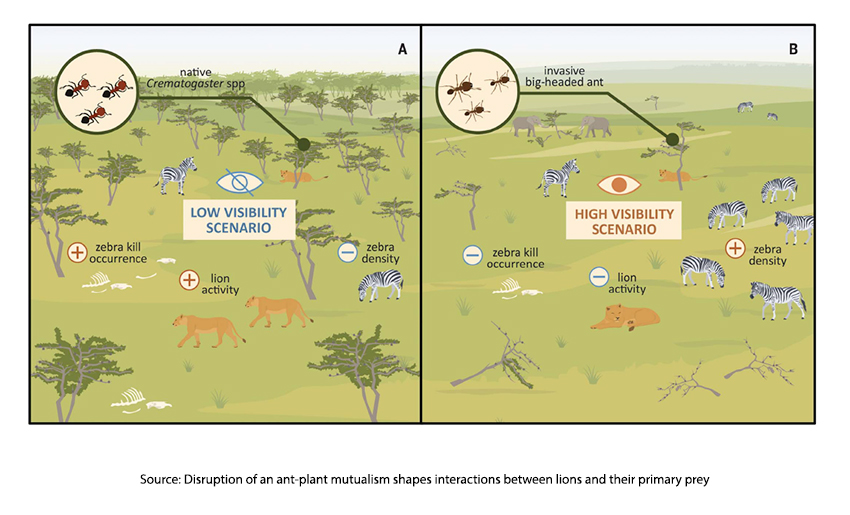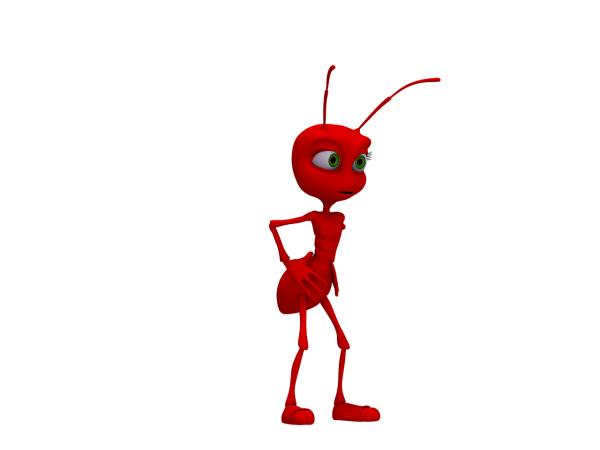I was a big fan of the series by James Burke, a science historian, called Connections, which described mutualism in the dance between scientific achievements and history, how they interconnect and build upon one another in ways more reminiscent of a drunken walk than a straight line. This new study in Nature reminded me of the great satisfaction I had listening to Connections, and I thought I would share what few of us would come across in our media diet.
Mutualism is everywhere. The actions of one species on another may benefit or harm one or the other or impact a species not directly involved in the original relationship. Mutualism describes our relationship with dogs, and that specific relationship affects entire companies built upon that mutualism, e.g., dog food, dog furniture, and dog doctors.
The study looks at an earlier form of nature in a portion of Kenya, Lakipia, a savannah or ecosystem characterized by open grasslands with scattered trees and shrubs, where
“…lions watch lazily from the shade beneath the umbrella-thorn (or Acacia tortilis) trees that dot the undulating landscape.”
The Ants Come Marching In
Our story begins in Laikipia with its “tens of thousands to hundreds of thousands of square kilometers” of whistling-thorn trees, “comprising >70% (and often 98 to 99%) of woody stems where it occurs.” These trees are myrmecophytes, “ant-plants,” with a mutualistic relationship with the native ants (Crematogaster mimosae). In exchange for the food shelter provided by the tree’s hollow thorns and nectaries, they defend the tree against its main predator, herbivores. When the ants are disturbed, they bite and emit formic acid against the herbivores while rubbing their bodies against the thorns, creating a whistling sound that makes the herbivore think twice before chowing down. As the researchers write,
“Protection by acacia ants is particularly effective at deterring lethal herbivory by elephants (Loxodonta africana), thereby stabilizing savanna tree cover across entire landscapes.”

Over the last twenty years, an interloper, the invasive species of bigheaded ant (Pheidole megacephala), has arrived. Big-headed ants “completely exterminate Crematogaster spp. ants” and do not protect those whistling-thorn trees. As a result, elephants destroy trees “at five to seven times the rate of that in uninvaded areas,” creating wide open spaces.
“We hypothesized that disruption of this foundational ant-tree mutualism would affect interactions between lions and their most common prey, plains zebra.”
Before proceeding, here are a few fun facts about these final two players in our mutualism drama. Zebras are not picky eaters but require large volumes of grass “to meet their nutritional needs.” So, zebras are a bit of a stationary target and represent about 50% of a lion’s diet. Contrary to what I thought, lions ambush their prey; they do not expend energy chasing after them. You can see how a landscape crowded with whistling-thorn trees would allow the zebras and lions to be more hidden and, over time, shape their predator-prey relationship.
Back to the study
In measuring visibility across the landscape with varying tree cover and big-headed ant invasion, they found nearly three-fold greater visibility in the areas where the big-heads had taken over.
As the researchers hypothesized and then found to be true:
“Big-headed ant invasion rendered whistling-thorn trees largely defenseless against elephants, leading to higher browsing rates and more open landscapes characterized by higher visibility.”
Their second hypothesis was that this greater visibility would shape the interaction of lions and zebras. Wide-open spaces make it more difficult for lions to ambush zebra while simultaneously giving zebra a better view of their surroundings. To search for an impact, if any, the researchers quantified
- Zebra density – how many and where on the savannah they were to be found
- Lion activity – using GPS trackers on six lionesses from distinct prides
- Zebra kills – where zebra remains were found along with estimates of the area’s visibility and presence of those big-headed ants.
“Consequently, zebra kill occurrence was 2.87 times higher in uninvaded areas relative to areas invaded by big-headed ants.”
Because of the changes in the landscape brought about by an ant, the zebra was no longer “what’s for dinner,” kills declined from 67 to 42%. Buffalo moved up on the entre list from 0 to 42%.

The chain is complete. Invasive big-headed ants disrupt the mutualism of native ants and whistling-thorn trees. That, in turn, makes the trees vulnerable to their predator, the elephant. The resulting increase in visibility disturbs the equipoise between the predator lion and the zebra prey, protecting the zebra while increasing the vulnerability of the buffalo.
“Foundational mutualisms structure some of the most iconic environments on Earth, including coral reefs, kelp forests, and, as evidenced in this work, African savannas. When such mutualisms are disrupted, their effects can reverberate across landscapes, to the detriment of some species and to the benefit of others.”
A final thought. We, too, have mutualistic relationships with one another and our human landscapes. It behooves us to tread lightly when those mutualisms are unclear or undiscovered. Do we really want a version of the big-headed ants disrupting our landscape for the detriment of some and the benefit of others?
Source: Disruption of an ant-plant mutualism shapes interactions between lions and their primary prey Science DOI: 10.1126/science.adg1464




